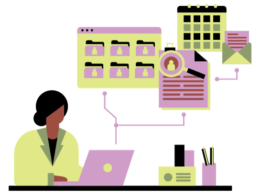In today’s dynamic and rapidly changing business landscape, human resources (HR) is undergoing a transformation like never before. Gone are the days when HR’s role was primarily administrative, focusing solely on paperwork and compliance.
Modern HR departments are embracing data-driven decision-making, and at the heart of this transformation are evolving metrics that go beyond traditional Key Performance Indicators (KPIs).
- Are you ready to explore how HR is breaking new ground with evolving metrics?
- How can these insights revolutionize your organization’s talent management strategies?
Join us on this enlightening journey as we dive deep into the exciting world of HR analytics and metrics.
The Changing Face of HR: A Paradigm Shift
In this section, we discuss the profound transformation that HR has undergone over the years. HR has evolved from being traditionally perceived as a mere cost center responsible for administrative tasks, such as payroll and compliance, to becoming a strategic partner integral to organizational success. This shift signifies a paradigm change in how businesses perceive and utilize their HR departments.
Why are we seeing this shift?
The fundamental question addressed here revolves around the reasons behind this transformation. The answer lies in recognizing that employees are a company’s most valuable asset.
Managing this asset effectively goes beyond routine tasks and necessitates a nuanced understanding of how HR practices directly influence overall business outcomes. In essence, it’s about realizing that investing in people yields long-term benefits.
What are these evolving metrics?
Having established the need for this transformation, the blog introduces the concept of evolving HR metrics as the driving force behind the shift. It highlights that modern HR professionals are no longer relying solely on basic metrics like headcount and turnover rates. Instead, they are embracing a diverse set of evolving metrics that provide deeper insights and facilitate data-backed strategies.
Let’s elaborate on each of the three evolving HR metrics:
A. Workforce Analytics: A 360-Degree View of Your Talent
Workforce analytics is a comprehensive approach to HR metrics that offers a holistic perspective on your organization’s talent. Unlike traditional HR Key Performance Indicators (KPIs) that often focus on surface-level data, workforce analytics dives deep into a range of data sources to provide a well-rounded understanding of your employees throughout their entire journey with the company.
1. Multiple Data Sources
Workforce analytics draws from various sources, including HR records, performance evaluations, employee surveys, and more. By aggregating and analyzing data from these diverse sources, HR professionals can gain a more comprehensive view of their workforce.
2. Holistic View
This approach offers a 360-degree view of the employee lifecycle, from recruitment to retirement. It allows HR teams to track and measure the impact of HR practices and policies at every stage, offering insights into what’s working and what needs improvement.
3. Key Questions Answered
Workforce analytics can answer critical questions, such as how specific recruitment strategies affect long-term employee performance, whether there’s a correlation between employee engagement and customer satisfaction, and how data-driven insights can enhance diversity and inclusion efforts.
It enables evidence-based decision-making, helping HR teams make strategic choices that align with the organization’s goals.
B. Predictive HR Analytics: Anticipating Future Trends
Predictive HR analytics is a game-changing approach that enables HR professionals to anticipate future trends, challenges, and opportunities. It relies on historical data and machine learning algorithms to forecast potential HR issues and take proactive measures to address them.
1. Historical Data Analysis
Predictive HR analytics starts by analyzing historical HR data, including employee turnover rates, performance evaluations, and workforce demographics. By identifying patterns and correlations in this data, HR teams can make predictions about future workforce trends.
2. Proactive Measures
Armed with predictive insights, organizations can take proactive measures to mitigate potential issues. For example, they can identify employees at risk of leaving and implement retention strategies; forecast skill gaps and plan for training; or predict workforce surges and adjust hiring strategies accordingly.
3. Real-World Effectiveness
Predictive HR analytics has a track record of success in reducing turnover, increasing employee productivity, and optimizing workforce planning. Real-world examples showcase how organizations have leveraged these insights to drive positive change.
C. Employee Experience Metrics: Measuring Satisfaction and Engagement
Employee experience metrics represent a more nuanced and holistic approach to understanding employee satisfaction and engagement. These metrics go beyond traditional satisfaction surveys to assess various aspects of the employee journey, including their emotional well-being and overall experience within the organization.
1. Measuring Satisfaction and Engagement
Employee experience metrics measure not only employee satisfaction but also engagement, well-being, and the overall experience of working in the organization. This provides a more comprehensive view of how employees perceive their roles and the workplace.
2. Impact on Retention and Productivity
Employee experience directly impacts retention rates and productivity levels. High levels of employee engagement and satisfaction are often associated with lower turnover and increased productivity. These metrics help organizations identify areas for improvement and design strategies to enhance the employee experience.
3. Cultivating a Positive Workplace Culture
By collecting and acting on employee experience data, organizations can create a more engaging and productive workplace culture. It empowers HR professionals to address pain points, celebrate strengths, and foster a positive environment that attracts and retains top talent.
The evolution of HR metrics represents a significant shift in the way organizations manage their talent. By moving beyond traditional KPIs and embracing these evolving metrics, HR professionals are becoming strategic partners in shaping the future of their companies.
So, are you ready to embark on this transformative journey?
Join us as we explore the world of HR analytics and metrics that are reshaping the way businesses manage their most valuable asset—people. It’s a journey filled with exciting possibilities, and the future of HR has never looked brighter. Stay tuned for more insights and success stories as we continue to unravel the power of evolving HR metrics.
 Pin
PinJoin Accredian’s Executive Program in Strategic HR Analytics in partnership with IMI Delhi and unlock the future of HR leadership.






